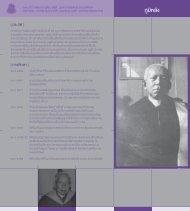Create successful ePaper yourself
Turn your PDF publications into a flip-book with our unique Google optimized e-Paper software.
136home, accompanied by bursts of fireworks that encouragedonlookers to view the works. The reputation of the bride couldbe enhanced or hurt by her needlework, so much so thatChiang’s grandmother sent ‘spies’ to listen for criticism of hissister’s handiwork.” (p. 106)SantamariaIndeed, the above-mentioned stories surrounding beadwork adda very human quality of urgency, desperation, and distinction to the craft.Beadwork may now be directly linked to the pride or shame of a certainhousehold. A Nyonya’s reputation may therefore rise or fall according tothe quality of her beadwork, a craft that functions to cultivate “adomesticated daughter and a dutiful wife.” (p. 112) Domestication, in asense, appears to be a function of the bead’s minuteness. Alternately,beadwork pieces may be viewed both as source of individual expressionand a technique of social oppression.Stories from informants also reveal the “transnational” nature ofNyonya beadwork. This aspect has less to do with the crossing of actualterritorial borders, rather it relates more to the inter-ethnic productionand consumption as the following paragraph indicates:“Non-Peranakan Chinese, Malays, and Peranakan Indiansowned and used Nyonya beaded and embroidered slippers.However, Nyonya and Nyonya-style beadwork (as distinct fromMalay beadwork in geometric and floral designs) was primarilyassociated with Peranakans. Samuel Doraisingham attributes thebeaded slippers worn by Melaka Chitty women to the influenceof the Peranakan Chinese with whom they had affinal bonds.Seventy-year-old Kamachee Pillay from the Melaka Chittycommunity also recalls that her grandmother used and madebeadwork. However, Pillay suggests that this beadwork was adirect result of the influence of the Melaka Peranakancommunity since her grandmother worked in a Peranakanhousehold and patronized the same craftsmen as the Peranakans.Making use of the beadwork thus carried a further implication—it allied the used with Peranakan culture and society, perhapseven reinforcing the association between beadwork andaffluence.” (p. 106)With very little doubt, to scholars the most useful part of the bookis chapter 4 which is titled Towards a Chronology of Nyonya Beadwork. Inthis chapter, the author details the challenges presented by the task ofdating extant pieces. On the one hand, information about the provenanceand production of beadwork hardly accompanies any of the extantartefacts. Scientific dating of actual beads, on the other hand, produces avery wide margin of error to be of any use for historical studies onbeadwork. Clearly, compared to pottery, jewellery or woodwork, forinstance, a different kind of sleuthing is needed in determining dates andprovenance among Nyonya beadwork pieces. Beadwork pieces that



